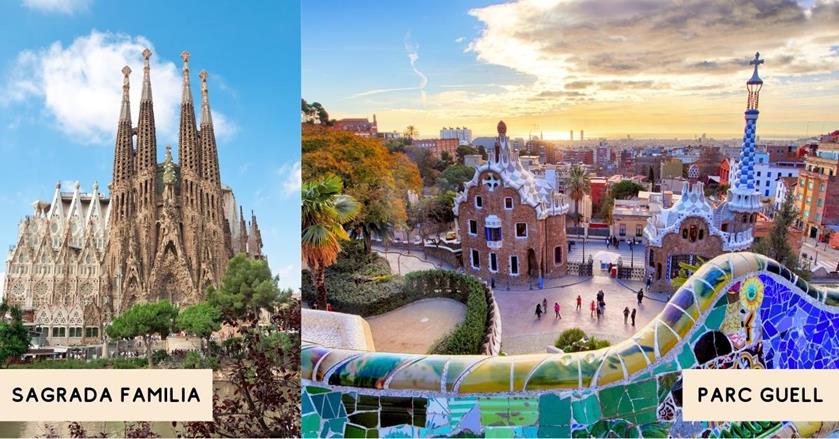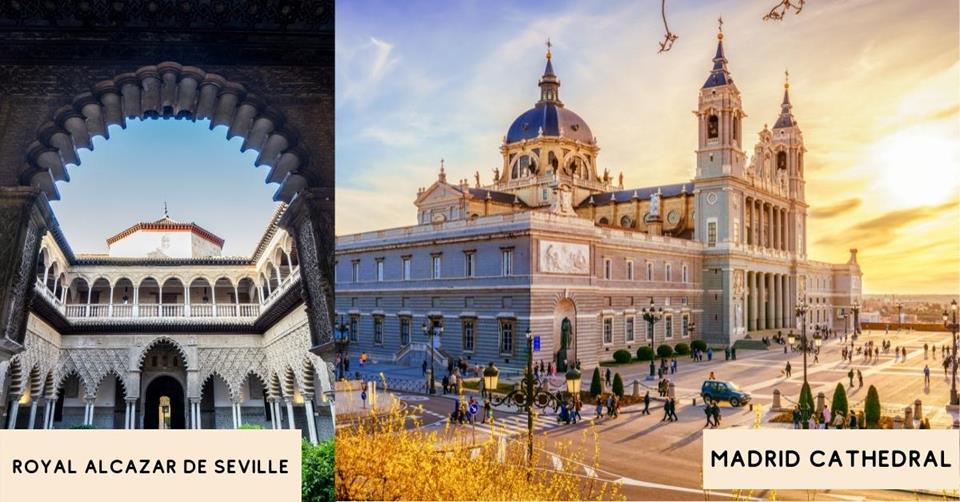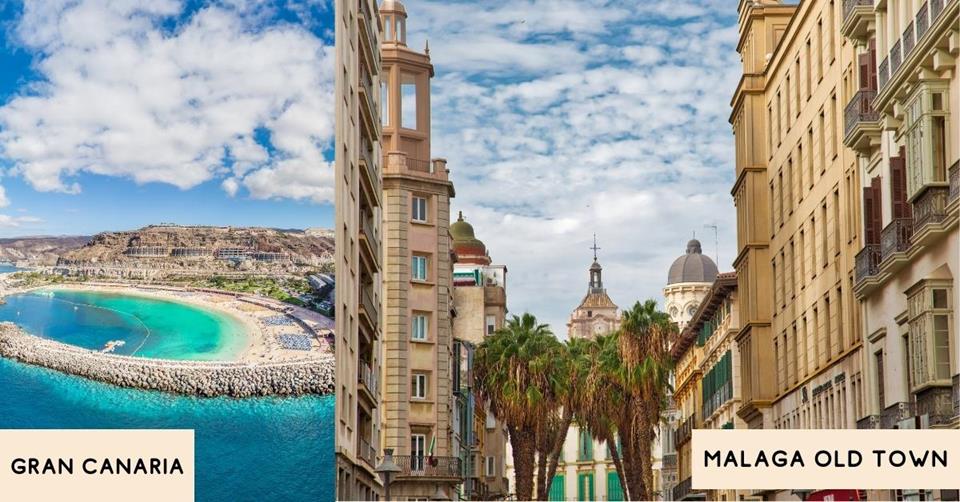Popularly known as one of the most visited countries in Europe, Spain offers its annual 82 million tourists with all grace and satisfaction. Evidently, the number of tourist arrivals in Spain just keeps growing every year with people who are keen to visit beaches, go hiking, explore ancient towns, and try out local dishes.
So, what is your reason for visiting Spain? Is it to treat yourself to local Spanish cuisine? Or perhaps to experience its rich history and culture through its beautiful architecture? Or maybe you want to experience its natural beauty and the Mediterranean coastline? The good news is – Spain has all these.
Travelling to Spain for an extended time is recommended. There are so many things to see or do throughout your tour.
This itinerary for 3 weeks in Spain should be enough to cover the best that Spain has to offer, especially for first-time visitors. We have prepared this itinerary to plan your trip seamlessly and conveniently.
If you want to visit other countries in this region, check out our 3 weeks in South Europe itinerary or do a trio adventure and go to Italy, France, and Spain for 3 weeks.
THINGS TO KNOW BEFORE GOING TO SPAIN

When you travel to Spain, it is important to learn basic Spanish phrases to make communication easier. Some can speak English, but some may not know the language at all. It is also important to know that drinking directly from the tap is safe. And tipping isn’t a big deal, so you are not required to leave a tip unless you are thrilled with the service.
As with any major tourist destination, pickpocketing can be an issue. Make sure you keep an eye on your belongings at all times. If it’s your first time travelling alone, check out our article on how to stay safe if you are travelling solo.
Here are more tips so you can better plan and write your 3-week itinerary. These tips will help you visualise and start having clarity on what your vacation will look like.
When is the best time to go to Spain
Choosing the best time to visit Spain can be a challenge since it is a great year-round destination. You generally decide the best time to go according to what you want to see or do. Each season offers a uniquely enjoyable experience, so you need to plan accordingly.
Spring (March to May) and fall (September to November) are the best times to go. This will provide you with good weather to enjoy the natural beauty and scenery of the country.
You can also expect fewer crowds (compared to winter and summer). And with fewer crowds, you can expect to find cheaper accommodations than when you book at other times of the year.
- Peak/summer season: June to August
- Heavy rains between September to January
- Winter season: December to February
One major holiday to remember when deciding when to go to Spain is Holy Week. During La Semana Santa, not only many businesses are closed, and locals not working, but there are parades and events surrounding this public holiday.
Make sure to book your hotel and other arrangements in advance if you plan to go during the Holy Week because it’s a peak season and last-minute booking will be expensive and challenging.
Are 3 weeks enough for Spain
3 weeks in Spain is perfect. You can visit historical sites, the beach, and even go for a hike or two. The country is also well-connected with flights and buses or trains, making travelling between cities or islands much easier. 20 days is plenty, and you won’t run out of things to do or feel like you have to cram everything and are always on the go.
If you’ve ever been to Spain or if you’re travelling here with your family and looking for something unique place to go to and spend your three weeks, perhaps this list of the best Spanish islands for families can be helpful. You can choose between popular spots and a tranquil peninsula to enjoy a peaceful atmosphere.
Average cost of 20 days in Spain
Plan to spend around $2,000 for a 3-week trip in Spain if you prefer to stay in a mid-range hotel and eat often. Accommodation costs you the most during your trip, around $40-$60 a night for a decent double room. Eating out in a mid-range restaurant will be about $7 to $12 per meal.
For those who want to travel more budget-wise, $1,200 could do it by staying in dorm rooms and eating street food most of the time. If your hostel has a kitchen, that could also cut costs. For luxury spenders, around $3,500 will be an excellent budget if you plan to book five-star hotels and fancier restaurants.
These numbers don’t include your flight to and from Spain and are calculated for one person. For couples or a pair of friends travelling, you could save some money by sharing a double room.
What to pack
Knowing what to pack for Spain will depend on what time of the year you want to go. The country enjoys a Mediterranean climate, meaning the winters are mild with some rain, while the summers are hot and dry. When you visit during the summer, opt for casual and lightweight clothes to keep you cool.
It can get quite cold during winter in Spain, skiing is even possible here in the parts of the Pyrenees region. It is important to pack lightweight layering items such as cardigans and sweaters. The winters are not harsh, but it can get chilly at night.
We have a series of packing lists. Check out our packing for a 3-week trip. We also have a summer trip packing list, and of course, a packing list for winter.
How to get around
Getting around Spain is relatively easy. The best way to travel from one Spanish city or town to another is by train, especially while you are on the mainland. The high-speed train is called AVE(Alta Velocidad), a convenient way to travel between cities.
You can also rent a car and drive on your own since Spain has a pretty straightforward policy regarding recognising international driver’s licenses. However, remember that most vehicles in Spain are programmed with a stick (aka manual gear). You can, of course, find automatic cars, but they get booked up quickly.
Buses are also easy and cheaper but can be slower, while traditional taxis are everywhere. The use of ride-hailing apps is also common, and domestic flights will come in handy when moving between islands.
Visa
Spain has the same visa policy in place as any other Schengen State member (EU). This means that visitors with passports from most parts of the Americas, Oceania, Malaysia, Singapore, South Korea, Japan, and some parts of the Middle East can enter and travel around Europe for 90 days in every 180-day calendar.
US Citizens can travel to Spain for leisure or business purposes without a visa with a maximum stay of 90 days. The only requirement is that your passport must be valid for 6 months (during the time of travel). Also, it must have at least one blank page.
In some cases, a return airline ticket and enough funds are required. Aside from US citizens, the following passport holders do NOT need a visa to travel to Spain: Members of the European Union, Switzerland, Iceland, Norway, Canada, most parts of Latin America, Japan, South Korea, Malaysia, Singapore, New Zealand, Australia, and some regions of the Gulf countries and Central Asia.
For others not mentioned, the visa must be applied in advance. You could submit your application as early as 6 months in advance.
Travellers with passports from EU-member or part of Schengen States have indefinitely freedom of movement in Spain. Other passport holders must arrange their travel visa for Schengen through the Spanish Embassy or Consulate near you.
Package tours
Sometimes planning is overwhelming, and you really want a vacation where you can simply show up at the airport, and the fun begins. In that situation, I love booking package tours. In such tours, the travel agency book and arrange everything for you. This includes accommodations, activities, restaurants, transportation, and a knowledgeable guide.
Below is a list of exciting tours for 15 to 22 days. Let’s say you have 20 days of vacation, and you want to be easy but leave you time to do your own thing. Go book the 15 days, then you have 5 days of exploring on your own.
Other travel tips
Booking your travel arrangements can be overwhelming. There are simply too many options, and comparing them to one another is a daunting and time-consuming task. I was planning my Central Europe itinerary last night, and it is just a few minutes to book the accommodation I want and the flights I need.
I was also able to make a decision quickly because I know that some of the travel sites I use offer a flexible cancellation policy. Here’s a list of the websites and tools I use for any travel-related services. Perhaps, you might find them helpful and easy to use as well.
MUST-SEE PLACES IN SPAIN (pinned map)
Click the enlarge button on the top right corner. Credit: map data: Google
3 WEEKS IN SPAIN ITINERARY
Spain is home to many beautiful cities and towns that are worth exploring for various reasons. Whether you want to enjoy culture, nature, or history, you will be spoiled for options. Use this guide, so you know what to see or do for each destination in Spain.
If you enjoy your trip to Spain, perhaps you want to spend 3 weeks in Italy next time or a trip to France. For people on a budget, here’s our list of how to travel to Europe in 3 weeks on a budget.
Day-to-day overview
- Day 1: Arrive in Barcelona. Arrange a private transfer to your hotel or take the airport shuttle bus. Pick up your rental car here at the airport if you plan to drive yourself. Get yourself a local sim card with data and local currency.
- Day 2-3: Explore Barcelona and plan some day trips, get the Hola card for public transport.
- Day 4: Travel from Barcelona to Valencia by bus, train, plane, or drive.
- Day 5-7: Discover Valencia, and don’t forget to enjoy the beach.
- Day 8: Travel from Valencia to Madrid by bus, drive, train, or plane.
- Day 9 to 11: Explore Madrid and plan some day trips from here.
- Day 12: Get to Seville from Madrid by train, plane, bus, or drive.
- Day 13 to 14: Discover Seville, and make sure to go to a flamenco bar.
- Day 15: Travel to Malaga or Granada, which is around 2 hours by driving or 2.5 hours by bus (Malaga/Granada).
- Day 15-17: Explore Granada or Malaga.
- Day 18: Fly to Tenerife or Gran Canaria or Ibiza.
- Day 18-21: Enjoy the island life and plan some relaxing days.
Barcelona for 4 days
Barcelona is probably the most popular city visited by tourists in Spain. It is known for its iconic architecture and beautiful Mediterranean location. It is rich in culture with a wide array of the iconic architect Gaudi’s works to explore. Barcelona is an ideal destination to start your 3 weeks in Spain trip, especially if you want to kick it off by relaxing on the beach and soaking up in the Mediterranean Sea.
Getting to Spain is very easy, there are two main destinations you can plan to start your trip – Barcelona and Madrid. Barcelona is as famous as Madrid, with non-stop flights from various cities in the US and Canada to Barcelona via American Airlines, Delta Airlines, Lufthansa, or Air Canada. The Josep Tarradellas Barcelona-El Prat International Airport in Barcelona is the central hub of flights and the second busiest airport in Spain.
Things to do in Barcelona
- Get a public transport pass – look at the price
- Mount Tibidabo
- Barceloneta Beach
- Basilica de la Sagrada Familia – skip the online and explore with an audio guide or combine with Parc Guell
- Casa Mila
- Barcelona Aquarium – suitable for young children, buy your ticket in advance
- Palau de la Musica Catalana
- Park Güell- get your ticket in advance, there’s a limit per day ticket sold for Parc Guell
- Casa Batllo
- Enjoy tapas and wine – book a walking tour
- Bogatell Beach/Playa de Bogatell
- Magic Fountain of Montjuic – ride a round-trip cable car
- Museo Picasso de Barcelona
- Explore Montserrate – join a half-day tour
- Camp Nou
- Trio-day trip and cover Spain, France, and Andorra – check the itinerary
- Walk around Barri Gotic
- Go kayaking and snorkelling in Costa Brava – book an affordable tour
Accommodations in Barcelona
- Affordable: Unite Hostel or Factory Hostel
- Mid-range: Sixties Ramblas or Violeta Boutique
- Luxury: Vincci Gala or Ohla Barcelona or ME Barcelona

Valencia for 3 days
Best known as the home of paella, Valencia is the home of luscious Spanish dishes. But aside from introducing the world to this culinary delight, there are more reasons to visit Valencia in Spain. Valencia is another Spanish coastal town 348 km (216 miles) south of Barcelona.
Taking a stroll through its old town will enable you to marvel at the colonial architecture. But Valencia is also home to many futuristic architectural features, such as the world-famous Valencia City of Arts and Sciences. Spending 3 days in Valencia is plenty, although 2 days is possible if you want to add that one day to another city.
To get to Valencia from Barcelona, you can either drive your rented car for 3 hours and 40 minutes or take the train, the journey is around 3 hours or by bus is about 4 hours. You can also book a direct 1-hour flight.
The best way to get around Valencia is by using public transportation. You can also rent a bicycle or buy yourself this useful hop-on hop-off bus ticket which stops at major attractions in Valencia.
Things to do in Valencia
- La Lonja de la Seda
- Oceanografic – perfect for young children, get your entrance ticket
- Albufera Natural Park
- La Ciutat de les Artes i les Ciencies de Valencia
- Cuevas de San Jose – sign up for a half-day guide tour
- Mercado Central
- Plaza de la Virgen
- Hike and swim at Montanejos – book a group tour
- Bioparc Valencia
- Torres de Serranos
- Playa del Saler
- Sail on a Catamaran Cruise – check the tour price
- The medieval town of Requena
- Enjoy wine and tapas tasting in an 11th-century historical monument – check this trip
- Join a cooking class
Accommodations in Valencia
- Affordable: Hostal Antigua Morellana or Colors Rooms
- Mid-range: Ad Hoc Carmen or Venecia Plaza Centro
- Luxury: Vincci Lys or Petit Palace Plaza de la Reina
Madrid for 4 days
3 weeks in Spain without visiting its capital is incomplete especially if it’s your first time here. Madrid is the artistic centre of Spain. Proof of that is the concentration of art galleries located in various parts of the city that showcase the works of Picasso and Velazquez. It is also home to a wide range of vibrant neighbourhoods that offer the best tapas and pubs to check out at night.
Madrid is located right in the centre of Spain, about 346 km (215 miles) northwest of Valencia. There are a few ways to get to Madrid from Valencia. You can book a direct 2-hour flight from Valencia Airport to Adolfo Suárez Madrid-Barajas Airport. You can also get to Madrid by train from Valencia with Avlo in 2 hours or by car, which takes nearly 4 hours.
Once you get to Madrid, you can easily move around on foot and use public transport. If you prefer a more convenient way to travel around, a push bike might be more suitable for you or you get a hop-on hop-off bus ticket with stops at the most popular attractions.

Things to do in Madrid
- Royal Palace – get your fast-access ticket
- Plaza Mayor
- Museo Nacional del Prado – purchase your ticket in advance
- Parque Natural de Peñalara and Sierra de Guadarrama National Park
- Visit Real Madrid’s Stadium (Santiago Bernabéu Stadium) – join a Bernabeu Stadium tour
- Buen Retiro Park and the Crystal Palace
- Puerta del Sol
- Fuente de Cibeles and Gran Via
- Temple of Debod
- Basilica de San Francisco el Grande
- Enjoy wine and tapas tasting – join a group tour
- Puerta de Alcala
- Watch a flamenco show with dinner
- National Museum of Romanticism
- Day trip to Avila and Segovia and visit historical sites or go to Toledo with a local guide
Accommodations in Madrid
- Affordable: Olblanc Plaza de Espana or Hostal Arrate
- Mid-range: II Castilla Madrid or Hotel Liabeny
- Luxury: Pestana CR7 Gran via Madrid or Palacio de Atocha
Seville for 3 days
Located within the province of Andalusia in Spain, Seville is best known for its flamenco culture. You can find plenty of flamenco bars in town. You can also visit many historical landmarks and museums to glimpse the town’s past.
The architectural landscape of Seville offers a mix of the old and the new, creating a beautiful contrast in the cityscape. If you prefer to see this region of Spain, perhaps a Southern Spain road trip would be an ideal adventure for you.
Seville is 532 km (330 miles) south of Madrid. You can book a direct train between Madrid and Seville called Renfre/AVE. The trip will take a little offer of 2.5 hours, you can also drive, which is about a little over 5 hours. A direct flight will take about an hour from Adolfo Suárez Madrid–Barajas Airport (MAD) to Seville Airport (SVQ).
Things to do in Seville
- Royal Alcazar of Seville
- Catedral de Seville
- Punta Umbria Beach
- Cascadas del Hueznar
- Real Alcazar
- Parque de Maria Luisa and Plaza de Espana
- Barrio de Santa Cruz
- Museo del Baile Flamenco
- Real Maestranza de Caballeria de Sevilla
- Palacio de la Condesa de Lebrija
- Metropol Parasol
- Torro del Oro
Accommodations in Seville
You can also check this list of best boutique hotels in Seville with swimming pools.
- Affordable: Hostel A2C or Pension Javier
- Mid-range: Hotel Casona de San Andreas or Cool Sevilla Hotel
- Luxury: Hotel Rey Alfonos X or Hotel Dona Maria
Granada or Malaga for 3 days
The city of Granada is like a Disney fairy tale that came to life. It is filled with cobblestone streets, snow-capped mountains, and enchanting fortresses. It is also notable for the abundance of Islamic art and architecture.
Granada’s excellent and unique identity sets it apart from many other Spanish cities. For this reason, the destination makes it a worthy addition to your 3-week itinerary in Spain. This city is known for its “free tapas” culture if you love tapas. If you sit in any restaurant, bar, or visit someone’s home, there are free tapas for everyone.
On the other hand, Malaga is another seaside city in the south of Spain. There are spectacular beaches, historical monuments, and varied museums. Pablo Picasso was from Malaga, when you explore the city, you’ll definitely see how proud this city of him is through displaying his art.
Both Granada and Malaga are on the east of Seville. Malaga is 205 km (127 miles) southeast of Seville, while Granada is 250 km (155 miles) east of Seville. A car will only take 2.5 hours to reach Granada from Seville and 2 hours to Malaga. There are direct trains to both cities from Seville but no direct flights to both cities.

Things to do in Malaga and Granada
Since Granada and Malaga are not too far, you can easily plan day trips from both cities. You can also explore Malaga’s must-see spots on a 2-hour segway guided tour.
- Alhambra (G)
- Sacromonte (G)
- Alhambra (G) – check the tour price or do a day trip from Malaga
- Nasrid Palaces (G)
- Enjoy a flamenco show in a cave restaurant – book your table
- Salobreña Beach
- Sierra Nevada National Park
- Alcazaba de Malaga
- Torre Vigía De Cerro Gordo – sign up for a snorkelling and kayak tour
- Malaga Old Town/Marbella Urban Wall
- Boat trip to Paseo de Los Delfine – check the price
- Jardin Botanico-Historico la Concepcion
- Caminito del Rey – book a guided tour to cross the suspension bridge
- Playa de la Malagueta
- Museo Picasso Malaga – get your ticket with an audio guide tour
- Centre Pompidou Malaga
- Do tapas tasting – join a walking tour
- Festival de Malaga
- Day trip to Gibraltar – book a day trip including a St Michael Caves visit
Accommodations in Malaga
- Affordable: COEO Pod Hostel or Hotel Zeus
- Mid-range: Petit Palace Plaza Malaga or Be Mate Malaga Centro
- Luxury: Soho Boutique Castillo de Santa Catalina or Vincci Seleccion Posada del Patio
Accommodations in Granada
- Affordable: Urban Dream Nevada or Pension Venecia Gomerez
- Mid-range: Nest Flats Granada or Room Mate Leo
- Luxury: Candil Suite Origen or Hospes Palacio de Los Patos or Palacete (adults only)
Tenerife or Gran Canaria or Ibiza for 3 days
The best way to finish off your 3 weeks in Spain vacation is by visiting its most fabulous and beautiful islands in the northern part of Africa. West of the Sahara desert is the islands of Tenerife and Gran Canaria. Apart from magnificent beaches, these two islands also offer the best hikes in Spain and vibrant nightlife.
As one of the most popular destinations for holidaymakers in Spain, Tenerife is located in the Canary Islands. It is well-known for its natural beauty. The most notable feature of Tenerife is its volcanic peaks that create lunar landscapes and otherworldly natural features. It is also home to some of the country’s most unique geological gems.
However, Tenerife is a big island for a limited time. So, it’s best to decide which part you prefer. Whether it’s Tenerife North or South, either should work since both have their own airport to get in and out back to mainland Europe.
Gran Canaria, on the other hand, is a fantastic location for water sports and exploring nature, and it’s one of the most LGBTQ+-friendly across all of Europe. Spend your day either doing active sports or simply lying on the beach, enjoying a book, and drinking fresh coconuts.
Ibiza is not in the Canary Islands; it’s located east of Valencia. It’s well-known that Ibiza is an exciting destination when it comes to nightlife and all-night rave parties. It’s very suitable for young travellers and everyone who enjoys parties and delicious cocktails. If you just want a quick peek at Ibiza, you can also simply book a trip when you are in Valencia.
Getting to Gran Canaria or Tenerife
Tenerife has 2 major airports, Tenerife North (TFN) and Tenerife South (TFS). You should be able to get on a direct flight from Malaga both to the north and south, if not, you might have to connect in Madrid. The travel time is between 3-7 hours, depending on the connection.
Gran Canaria only has one airport (LPA), to get here from Malaga, you can get on a direct flight which is about 2.5 hours.

Things to do in Gran Canaria
- Pico de las Nieves
- Reserva Natural Especial de las dunas de Maspalomas
- Go scuba diving – book a tour
- Playa Puerto Rico
- Drive an ATV – enjoy a tour
- Roque Nublo
- Enjoy a submarine tour – read the reviews
- Palmitos Park
- Sign up for a morning cruise – check the price
Accommodations in Gran Canaria
- Affordable: La Hoyilla Hostel or Mountain Hostel Finca La Isa
- Mid-range: La Cason Canaria or Hotel Rural Hacien del Buen Suceso
- Luxury: Hotel the Lumm or Hotel Cordial or Wavia Hotel (adults only)
Things to do in Tenerife
- Lago Martianez
- Playa de Las Teresitas
- Mount Teide National Park
- Siam Water Park – get your tickets
- Whale and dolphin watching
- Museum of Science and the Cosmos
- Fuerteventura – do a 4×4 tour
- Cueva del Viento
- Masca Village
- Tabaiba Shipwreck/Pecio de Tabaiba
- Bajamar Natural Pools/Piscina Natural de Bajamar Teneriffa
- Sign up for a whale and dolphin watching tour or do a kayak tour while looking for dolphins and turtles
Accommodations in Tenerife
- Affordable: Albergue San Jose de Los Llanos or Hotel Las Canadas
- Mid-range: Hotel Adonis Plaza or Alua Tenerife
- Luxury: Hotel Hacienda del Conde or Gran Melia Palacio de Isora Resort & Spa
Things to do in Ibiza
- Join an all-inclusive boat party
- Cala Comte
- Platja de Cala Xarraca – Paul
- Cala Salada
- Platja d’en Bossa
- Cala Benirras
- Cala Bassa – book a 6-hour boat trip around Ibiza
- Cala d’Hort
- Ses Salines
- Hike Camino Al Faro De Moscater
- Faro de Punta Grossa
- Tore de Companitx
- Castell d’Elvissa/Castle of Ibiza
- Book a snorkelling and SUP paddle tour
Accommodations in Ibiza
- Affordable/Mid-range: Hotel Florencio or Lux Isla
- Luxury: Aparthotel Duquesa Playa or THB Los Molinos (adults only)
MUST-TRY SPANISH DISHES AND DRINKS
During your trip for 3 weeks in Spain, make sure you try the local dishes. You can taste so much food and see which ones are your favourite. The best way to do this is either by joining an affordable food tour or visiting at least 2-3 restaurants in each city you explore.
Spain has a rich culinary history. Many of the tourists who come to Spain seek out one of its many culinary specialities to get a taste of its rich culture. The dishes reflect the natural produce of the region where they come from and its cultural tradition. Discover the best dishes that you need to try when in Spain.

Paella
As the traditional and most popular dish in Spain, Paella is a rice dish cooked with various ingredients. It showcases local produce and fresh catch of the day.
Arroz Negro (or paella made with squid ink) is one of the most sought-after kinds of Paella. But you can also find seafood paella or paella Valencia, among other varieties of this dish.
Churros
Churros are fried, sugary sticks, probably Spain’s most notable dessert. This crunchy pastry is often dipped in hot chocolate or fudge. If you are looking for a dessert to cap off your meal, it is recommended that you order one.
Gazpacho
As a dish that is made with ripe tomatoes, garlic, olive oil, cucumbers, and peppers, Gazpacho stands as one of the best Spanish cuisines. All of these ingredients are blended to create a smoothie-like consistency. This dish is best served cold and is perfect for summer. It is also a great dish to try for vegans and vegetarians.
Spanish Croquetas
The Spanish croquet is another must-try dish when you travel to Spain. This dish is Spain’s version of fried balls, but instead of meat, this can also be made with vegetables.
When looking for vegan options in Spain, make sure to ask for the meatless croqueta. They are served in various restaurants in Spain and meat. It is replaced with mushrooms, pine nuts, spinach, or blue cheese.
SUMMARY OF 3-WEEKS IN ITINERARY
Spain will spoil your senses with the most delicious food, best sights, and remarkable attractions you won’t find elsewhere. Spain is rich in history, medieval architecture, delicious dishes, fantastic beaches, and endless outdoor activities, you won’t run out of things to do in Spain.
If you are looking for a great beach destination for a 3-week vacation, make sure to consider Spain, and the destinations recommended here. I hope that you found this 3 weeks in Spain itinerary helpful.
SAVE THIS TRAVEL ITINERARY ON YOUR PINTEREST:

